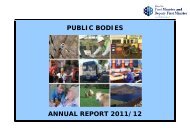strategy_to_enhance_and_develop_the_ulster_scots_language__heritage_and_culture_2015-2035
strategy_to_enhance_and_develop_the_ulster_scots_language__heritage_and_culture_2015-2035
strategy_to_enhance_and_develop_the_ulster_scots_language__heritage_and_culture_2015-2035
Create successful ePaper yourself
Turn your PDF publications into a flip-book with our unique Google optimized e-Paper software.
1.10 Tha lannin, fordèrin an confoarmin o tha<br />
Scotch leid in Ulstèr stairtit in troth wi<br />
tha muckle heftins o tha 16 hunnèrs.<br />
Thir taen in a Plentin ploy at tha sicht o<br />
Kïng Jamie Sïxt hissel eftèr tha Conjynin<br />
o tha Croons in 16an03 an tha Hamil<strong>to</strong>n-<br />
Megommerie ploy ’at cum afore this. Tha<br />
feck o fowk ’at cum frae lallan Scoatlan<br />
furtae heft in Ulstèr thon time taaked a<br />
kine o a Scotch steid o Inglish or tha<br />
Gaalic (tha leid o tha Heilans an Islans).<br />
Tha forehannit uise o tha vocable<br />
‘Ulstèr-Scotch’ ’at <strong>the</strong>’ ken o (fur tha<br />
fowk mair nor thair taak) gaes baak til<br />
16an40. Seein tha maist feck o tha Lallan<br />
Scotch daednae wun til Ulstèr tae tha<br />
16an90s, it wad be faisible tae mint ’at<br />
Ulstèr-Scotch as a sindèrie taaked<br />
swaatch o Scotch cums oot o tha<br />
seiventaen hunnèrs mair nor tha sïxtaen<br />
hunnèrs. Ower tha hunnèrs o yeirs<br />
atween, tha leid o tha Scotch incummers<br />
haes weered an thraa’ed intil a byordnar<br />
Ulstèr kine o Scotch.<br />
1.11 Forbye, tha incummers brocht an<br />
grai<strong>the</strong>d thair ain by-ordnar cultùral<br />
hamelt daeins, takkin in lettèrs an<br />
airtistic ootlats; releegious an pairtie<br />
gates; knackie skeels tha like o biggin,<br />
fairmin an <strong>to</strong>on ettlin; an kines o mellin<br />
an sillerie guidin.<br />
1.12 Theday tha inpit o tha Scotch plentèrs<br />
ky<strong>the</strong>s athort oor resydentèrs in<br />
sindèrie wyes, takkin in oor gates adae<br />
wi relïgion an poaliticks, an adae wi<br />
musick an daunce, forbye whut we hae<br />
tae oor mait an tha wye we taak.<br />
Figgers adae wi Ulstèr-Scotch<br />
1.13 Thair’s monie a yin amang resydentèrs<br />
’at leuks tha gate o tha Ulstèr-Scotch<br />
hamelt daeins an cultùral maitters. Yins<br />
makkin repone til tha Aa-lappin Scance o<br />
Aprile 20an10 gien wut ’at 49 in ilka<br />
1.10 The arrival, <strong>develop</strong>ment <strong>and</strong> adaptation<br />
of <strong>the</strong> Scots <strong>language</strong> in Ulster began in<br />
earnest with <strong>the</strong> large-scale settlements<br />
of <strong>the</strong> 17 th century. These included a<br />
Plantation scheme personally<br />
supervised by King James following <strong>the</strong><br />
Union of <strong>the</strong> Crowns in 1603 <strong>and</strong> <strong>the</strong><br />
Hamil<strong>to</strong>n-Montgomery scheme which<br />
preceded this. Most of <strong>the</strong> people who<br />
came from lowl<strong>and</strong> Scotl<strong>and</strong> <strong>to</strong> settle in<br />
Ulster at this period spoke a version of<br />
Scots ra<strong>the</strong>r than English or (as in <strong>the</strong><br />
Highl<strong>and</strong>s <strong>and</strong> Isl<strong>and</strong>s) Gaelic. The first<br />
known use of <strong>the</strong> term ‘Ulster Scots’ (for<br />
<strong>the</strong> people ra<strong>the</strong>r than <strong>the</strong>ir speech)<br />
dates from 1640. As <strong>the</strong> largest group of<br />
Lowl<strong>and</strong> Scots arrived in Ulster as late<br />
as <strong>the</strong> 1690s it is plausible <strong>to</strong> suggest<br />
that Ulster Scots as a distinct spoken<br />
variety of Scots is a product of <strong>the</strong> 18 th<br />
ra<strong>the</strong>r than <strong>the</strong> 17 th century. The<br />
Scottish settlers’ <strong>language</strong> has over <strong>the</strong><br />
centuries slowly <strong>develop</strong>ed <strong>and</strong><br />
transmuted in<strong>to</strong> a distinctive Ulster<br />
variety of Scots.<br />
1.11 The settlers also brought <strong>and</strong> <strong>develop</strong>ed<br />
<strong>the</strong>ir own distinctive cultural traditions,<br />
including literary <strong>and</strong> artistic idioms;<br />
religious <strong>and</strong> political ideals; practical<br />
skills such as building, farming <strong>and</strong> <strong>to</strong>wn<br />
planning; <strong>and</strong> forms of social <strong>and</strong><br />
economic organisation.<br />
1.12 Today <strong>the</strong> influence of <strong>the</strong> Scottish<br />
settlers can be seen across our<br />
community in a variety of ways<br />
including in religious <strong>and</strong> political life, in<br />
musical <strong>and</strong> dance traditions as well as<br />
in <strong>the</strong> food we eat <strong>and</strong> <strong>the</strong> way we speak.<br />
Statistics on Ulster Scots<br />
1.13 There is extensive public interest in <strong>the</strong><br />
Ulster-Scots tradition <strong>and</strong> cultural<br />
issues. Respondents <strong>to</strong> <strong>the</strong> Omnibus<br />
Survey of April 2010 indicated that 49%<br />
agreed that Ulster Scots plays an<br />
7



